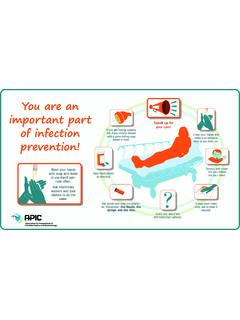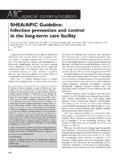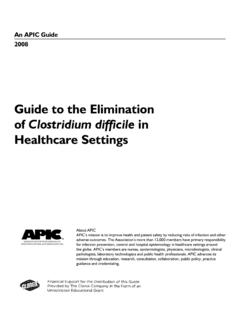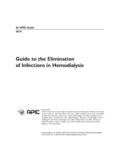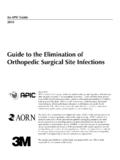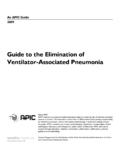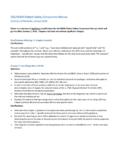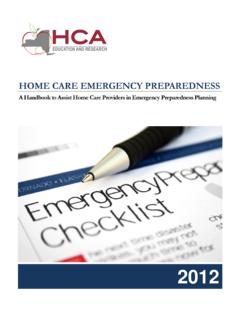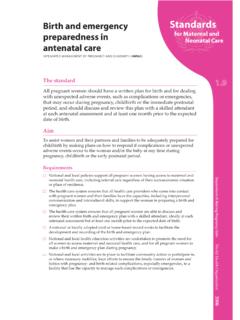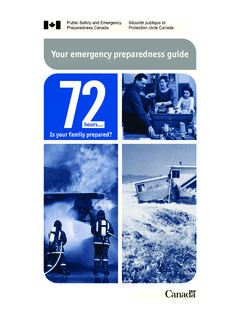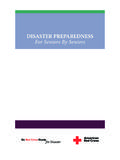Transcription of APIC State-of-the-art Report: The role of the …
1 apic State-of-the-art Report: The role of the infection preventionist in emergency management Terri Rebmann, PhD, RN, CIC,a and The 2008 apic emergency preparedness Committee St. Louis, Missouri Background: This report summarizes the scope and role of infection preventionists in emergency management for all types of disasters. Preventing the transmission of infectious agents during a disaster is an essential component of emergency management . Previous disasters have illustrated the need for better infection prevention and the involvement of an infection prevention profes- sional in planning for and responding to such events.
2 Methods: An evidence-based approach was used, consisting of a literature review and review by members of the Association for Professionals in Infection Control and Epidemiology, Inc, emergency preparedness Committee. Results: Nine domains were identified that describe the role of the infection preventionist in emergency management : knowledge of disasters and emergency management , assessing readiness and emergency management plans, infection prevention coverage, participation in disaster response and recovery, health care policy development, surveillance, patient management , physical plant issues, and infection preventionist as educator.
3 Details for each domain are provided. Conclusion: Infection preventionists need to become more involved in emergency management at the personal, facility, and com- munity level. This report outlines the infection preventionist 's responsibilities related to emergency management . Key words: emergency preparedness ; hospital preparedness ; surge capacity; infection prevention; infection control. Copyright 2009 by the Association for Professionals in Infection Control and Epidemiology, Inc. (Am J Infect Control 2009;37:271-81.). Infection transmission and infectious disease out- likely result in the largest public health impact in terms breaks can occur during or following any type of disas- of infectious disease-related morbidity, mortality, and ter.
4 The greatest risk of infection transmission occurs costs would be a pandemic. The 1918 Spanish influ- during a disaster involving an infectious disease/agent enza pandemic caused 40 to 50 million deaths world- (ie, an infectious disease disaster), such as a bioterror- Estimated costs for a future pandemic range ism attack, outbreak of an emerging infectious disease, from $71 to $166 billion4 and could require the need or pandemic. An infectious disease disaster can have a for 45 million additional outpatient visits to health major impact on morbidity, mortality, and costs, care agencies and between 865,000 and 9,900,000.
5 Regardless of whether it is an intentional event, such as bioterrorism, or a naturally occurring incident, Even natural disasters can have a significant public such as a pandemic. For instance, the 2001 anthrax bi- health impact if infection prevention and control strat- oterrorism attack resulted in 22 cases of illness and 5 egies are not implemented rapidly and deaths and cost more than $ Larger bioter- Past natural disasters, such as Hurricane Katrina and rorism attacks or ones involving a communicable dis- other events requiring the sheltering of displaced indi- ease, such as smallpox, have the potential for an even viduals.
6 Resulted in infectious disease outbreaks be- greater public health The disaster that would cause of overcrowding and the lack of hand hygiene or infection prevention procedures in ,7 Re- searchers who interviewed infection preventionists From the Institute of Biosecurity,a St. Louis University, School of Public (IP) involved in past disaster response reported a vari- Health, St. Louis, MO. ety of infection prevention issues that need to be Address correspondance to Terri Rebmann, PhD, RN, CIC, Associate addressed in future Such topics include Director for Curricular Affairs, Institute of Biosecurity, Assistant infection prevention for shelters; surveillance; occupa- Professor, Division of Environmental and Occupational Health, St.
7 Louis University, School of Public Health, 3545 Lafayette Ave, Suite 361, tional health during disasters; participation in the inci- St. Louis, Missouri 63104. E-mail: dent command structure; and need for patient, staff, Conflicts of interest: None to report. and visitor Historically, IPs have responded to health care-asso- 0196-6553/$ ciated infections and public health infectious disease Copyright 2009 by the Association for Professionals in Infection Control and Epidemiology, Inc. outbreaks. Toward the end of the 20th Century, many IPs expanded their role and became involved in bioter- rorism preparedness More recent events, 271.
8 272 Rebmann American Journal of Infection Control May 2009. such as severe acute respiratory syndrome (SARS) and role of IPs in emergency management were excluded. Hurricane Katrina, have illustrated the importance of Data from the relevant sources identified through the IPs becoming involved in emergency management for literature review and Internet search were extracted. all types of disasters to decrease secondary morbidity A spreadsheet was created that delineated the IP's and mortality. The IP's role in emergency management duty/task(s) or role(s) in emergency management iden- is considered to be essential, regardless of whether it is tified by each source.
9 An infectious disease emergency or some other type of ,9-13 What is lacking is a delineation of the IP's apic -sponsored emergency preparedness Mini role in emergency This is needed to Summit help guide IPs as they are called to the emergency management table to help make important planning In May 2008, the apic hosted a Mini Summit on Emer- and response decisions. gency This meeting involved representa- tives from a variety of key organizations involved in METHODS emergency management , including local and state public health agencies, Department of Homeland Security, The aim of this project was to delineate the role of IPs National Association of City and County Health Officials, in all phases of emergency management .
10 The role of the Centers for Disease Control and Prevention (CDC), Amer- IP in emergency management was developed using an ican Society of Healthcare Engineering, Federal Emer- evidence-based approach consisting of the following gency management Agency, first responder agencies, steps: (1) review of literature, (2) review of meeting Pro- home health, long-term care, academic institutions, in- ceedings from the Mini Summit on emergency Prepared- dustry partners, and other agencies/groups. The goal of ness hosted by the Association for Professionals in this Mini Summit was to begin a dialogue about the Infection Control and Epidemiology, Inc ( apic ) in May apic and IPs' roles in emergency management .
